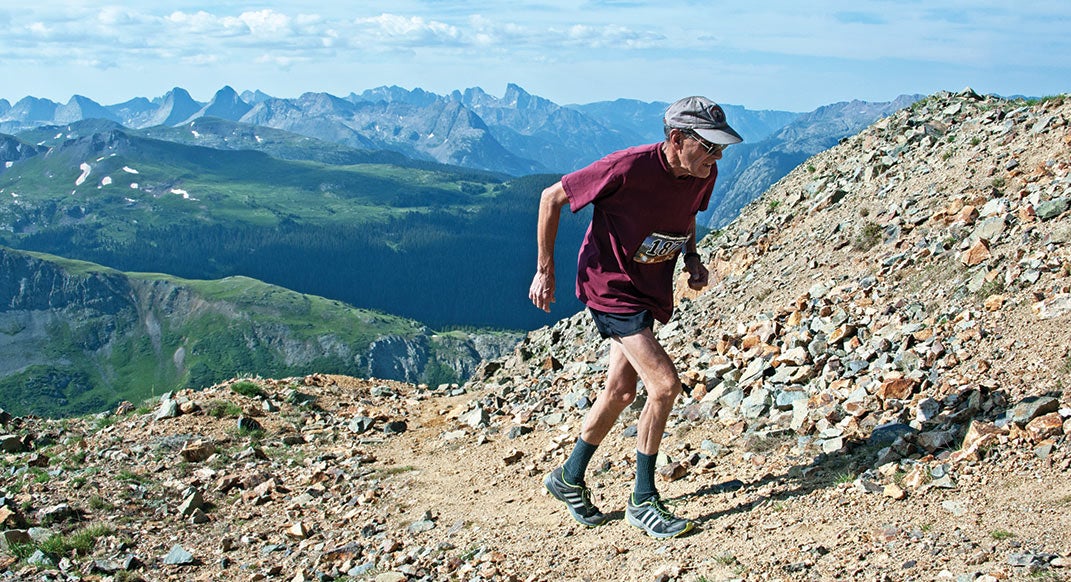Learning From a Legend

“It’s painful not to be able to run when it’s what I love so much,” Trujillo said, showing me the temperamental left knee that had prevented him from training for the past several months. The 67-year-old Hardrock veteran and 1996 winner was crewing for 55-year-old Ricky Denesik, a longtime friend and running partner from nearby Telluride. “But even when I’m injured, the thought of running keeps me going.”
An All-American runner at the University of Colorado, a U.S. Cross Country Team qualifier and a lifelong mountain-running pioneer, Trujillo has a list of accomplishments about as long as a novel. In addition to five consecutive Pikes Peak Marathon victories (1973-1977) and a record-setting ascent of Colorado’s 54 14,000-foot peaks in 1995, Trujillo founded the Imogene Pass Run in 1974, a historic 17.1-mile mountain race that connects the towns of Ouray (7,810 feet) and Telluride (8,750 feet) by way of a 13,114-foot pass. In 1992, he was one of four runners who scouted the original Hardrock course.
“Long before Gordy Ansleigh or Tom Johnson, energy gels, selfies or compression socks,” says fellow Hardrock veteran and longtime friend Roch Horton, of Salt Lake City, “Rick was pioneering the idea of mountain running beyond mere sport, but more as a way of being. He quietly and selflessly laid down times that stood for decades.”
By vocation, Trujillo is a geologist (“I wanted to know what I was running on”). That career has allowed him to travel to many parts of the world, particularly South America. Today, the bachelor still travels, but spends substantial time at his home in Ouray. Though years removed from competitive racing, Trujillo remains as passionate about trail running as on the spring day in 1963 when he ran his very first trail.
As Trujillo waited for Denesik in a collapsible camp chair at the aid station, staring into the darkness for a headlamp, he opened up about his running career.
How did you get into trail running?
As freshmen in high school, in 1963, my track teammates and I ran through a light snowstorm up a steep dirt road until we found ourselves postholing up to our waists. My teammates thought it was ridiculous, but I knew right then and there that running on the mountain roads and trails was something I really liked.
Did you continue trail running throughout your college track and cross-country career?
I attended University of Colorado Boulder on a partial track scholarship, but 1966 was a different era in that road running was just beginning and trail running was virtually non-existent.
When my coach forbade us from running on the trails (“The mountains are no place for a runner!”), I kept quiet but completely ignored his directive—mountain trail running is what running was and still is to me. By my senior year [1969-70], it had become normal for all CU runners to run the trails for their morning runs, but it was uncommon to see other trail runners.
What kind of running do you do today?
In the late spring, summer and early fall I still run the trails and roads above Ouray. I have kept daily diaries since 1971 documenting most of my runs.
Running for me was never a means of gaining fame or fortune. Rather, it has always been a means of exploring the mountains, meeting their challenges and experiencing spiritual grandeur and natural beauty. I learned long ago that the mountains won’t look out for me, and many times I found myself in a “do or die” situation just to get back home.
What do you think about the state of trail running today?
Having begun in an era when trail running was for eccentrics, I am absolutely astounded. Back then, I would encounter someone on a trail above Ouray only once every two or three years. It was so rare that I would always stop and ask what they were doing there. Now if I run a trail and don’t see anyone, it’s the exception.
This article originally appeared in our January 2016 issue.